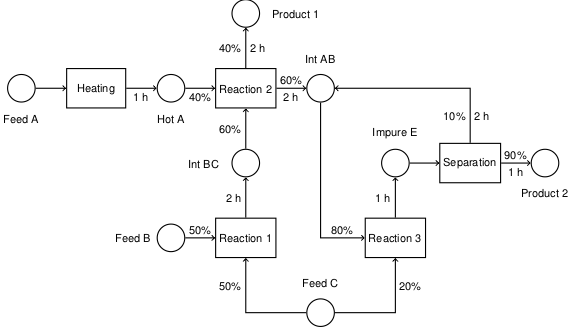4.3. Job Shop Scheduling#
Keywords: job shop, scheduling, cbc usage, neos usage, cplex, gdp, disjunctive programming, batch processes
4.3.1. Imports#
The following cell specifies the solver to used in the subsequent calculations. Some of these problems can become quite larger, and therefore the gurobi solver has been set as a default. If you don’t have the gurobi solver then adjust the code to use the glpk solver, but know the calculations may take longer (and the benchmark problem will not solve at all). If you do have the gurobi solver, edit the location of the executable to match the location on your computer.
%matplotlib inline
import matplotlib.pyplot as plt
import matplotlib as mpl
import pandas as pd
import shutil
import sys
import os.path
if not shutil.which("pyomo"):
!pip install -q pyomo
assert(shutil.which("pyomo"))
if not (shutil.which("cbc") or os.path.isfile("cbc")):
if "google.colab" in sys.modules:
!apt-get install -y -qq coinor-cbc
else:
try:
!conda install -c conda-forge coincbc
except:
pass
assert(shutil.which("cbc") or os.path.isfile("cbc"))
from pyomo.environ import *
from pyomo.gdp import *
4.3.2. Background#
A job shop consists of a set of distinct machines that process jobs. Each job is a series of tasks that require use of particular machines for known duration, and which must be completed in specified order. The job shop scheduling problem is to schedule the jobs on the machines to minimize the time necessary to process all jobs (i.e, the makespan) or some other metric of productivity. Job shop scheduling is one of the classic problems in Operations Research.
Data consists of two tables. The first table is decomposition of the jobs into a series of tasks. Each task lists a job name, name of the required machine, and task duration. The second table list task pairs where the first task must be completed before the second task can be started. This formulation is quite general, but can also specify situations with no feasible solutions.
4.3.3. Job shop example#
The following example of a job shop is from from Christelle Gueret, Christian Prins, Marc Sevaux, “Applications of Optimization with Xpress-MP,” Dash Optimization, 2000.
In this example, there are three printed paper products that must pass through color printing presses in a particular order. The given data consists of a flowsheet showing the order in which each job passes through the color presses

and a table of data showing, in minutes, the amount of time each job requires on each machine.
Machine |
Color |
Paper 1 |
Paper 2 |
Paper 3 |
|---|---|---|---|---|
1 |
Blue |
45 |
20 |
12 |
2 |
Green |
- |
10 |
17 |
3 |
Yellow |
10 |
34 |
28 |
What is the minimum amount of time (i.e, what is the makespan) for this set of jobs?
4.3.4. Task decomposition#
The first step in the analysis is to decompose the process into a series of tasks. Each task is a (job,machine) pair. Some tasks cannot start until a prerequisite task is completed.
Task (Job,Machine) |
Duration |
Prerequisite Task |
|---|---|---|
(Paper 1, Blue) |
45 |
- |
(Paper 1, Yellow) |
10 |
(Paper 1,Blue) |
(Paper 2, Blue) |
20 |
(Paper 2, Green) |
(Paper 2, Green) |
10 |
- |
(Paper 2, Yellow) |
34 |
(Paper 2, Blue) |
(Paper 3, Blue) |
12 |
(Paper 3, Yellow) |
(Paper 3, Green) |
17 |
(Paper 3, Blue) |
(Paper 3, Yellow) |
28 |
- |
We convert this to a JSON style representation where tasks are denoted by (Job,Machine) tuples in Python. The task data is stored in a Python dictionary indexed by (Job,Machine) tuples. The task data conists of a dictionary with duration (‘dur’) and (Job,Machine) pair for any prerequisite task.
TASKS = {
('Paper_1','Blue') : {'dur': 45, 'prec': None},
('Paper_1','Yellow') : {'dur': 10, 'prec': ('Paper_1','Blue')},
('Paper_2','Blue') : {'dur': 20, 'prec': ('Paper_2','Green')},
('Paper_2','Green') : {'dur': 10, 'prec': None},
('Paper_2','Yellow') : {'dur': 34, 'prec': ('Paper_2','Blue')},
('Paper_3','Blue') : {'dur': 12, 'prec': ('Paper_3','Yellow')},
('Paper_3','Green') : {'dur': 17, 'prec': ('Paper_3','Blue')},
('Paper_3','Yellow') : {'dur': 28, 'prec': None},
}
4.3.5. Model formulation#
Each task is indexed by an ordered pair \((j,m)\) where \(j\) is a job, and \(m\) is a machine. Associated with each task is data describing the time needed to perform the task, and a preceding task that must be completed before the index task can start.
Parameter |
Description |
|---|---|
\(\text{dur}_{j,m}\) |
Duration of task \((j,m)\) |
\(\text{prec}_{j,m}\) |
A task \((k,n) = \text{prec}_{j,m}\) that must be completed before task \((j,m)\) |
The choice of decision variables for this problem are key to modeling. We introduce \(makespan\) as the time needed to complete all tasks. \(makespan\) is a candidate objective function. Variable \(start_{j,m}\) denotes the time when task \((j,m)\) begins.
Decision Variables |
Description |
|---|---|
\(\text{makespan}\) |
Completion of all jobs |
\(\text{start}_{j,m}\) |
Start time for task \((j,m)\) |
The constraints include lower bounda on the start and an upper bound on the completion of each task \((j,m)\)
Any preceding tasks must be completed before task \((j,m)\) can start.
Finally, for every task performed on machine \(m\), there can be no overlap among those tasks. This leads to a set of pair-wise disjunctive constraints for each machine.
avoids conflicts for use of the same machine.
4.3.6. Pyomo implementation#
The job shop scheduling problem is implemented below in Pyomo. The implementation consists of of a function JobShopModel(TASKS) that accepts a dictionary of tasks and returns a Pyomo model.
def jobshop_model(TASKS):
model = ConcreteModel()
# tasks is a two dimensional set of (j,m) constructed from the dictionary keys
model.TASKS = Set(initialize = TASKS.keys(), dimen=2)
# the set of jobs is constructed from a python set
model.JOBS = Set(initialize = list(set([j for (j,m) in model.TASKS])))
# set of machines is constructed from a python set
model.MACHINES = Set(initialize = list(set([m for (j,m) in model.TASKS])))
# the order of tasks is constructed as a cross-product of tasks and filtering
model.TASKORDER = Set(initialize = model.TASKS * model.TASKS, dimen=4,
filter = lambda model, j, m, k, n: (k,n) == TASKS[(j,m)]['prec'])
# the set of disjunctions is cross-product of jobs, jobs, and machines
model.DISJUNCTIONS = Set(initialize = model.JOBS * model.JOBS * model.MACHINES, dimen=3,
filter = lambda model, j, k, m: j < k and (j,m) in model.TASKS and (k,m) in model.TASKS)
# load duration data into a model parameter for later access
model.dur = Param(model.TASKS, initialize=lambda model, j, m: TASKS[(j,m)]['dur'])
# establish an upper bound on makespan
ub = sum([model.dur[j, m] for (j,m) in model.TASKS])
# create decision variables
model.makespan = Var(bounds=(0, ub))
model.start = Var(model.TASKS, bounds=(0, ub))
model.objective = Objective(expr = model.makespan, sense = minimize)
model.finish = Constraint(model.TASKS, rule=lambda model, j, m:
model.start[j,m] + model.dur[j,m] <= model.makespan)
model.preceding = Constraint(model.TASKORDER, rule=lambda model, j, m, k, n:
model.start[k,n] + model.dur[k,n] <= model.start[j,m])
model.disjunctions = Disjunction(model.DISJUNCTIONS, rule=lambda model,j,k,m:
[model.start[j,m] + model.dur[j,m] <= model.start[k,m],
model.start[k,m] + model.dur[k,m] <= model.start[j,m]])
TransformationFactory('gdp.hull').apply_to(model)
return model
jobshop_model(TASKS)
<pyomo.core.base.PyomoModel.ConcreteModel at 0x7f8082e1a400>
def jobshop_solve(model):
SolverFactory('cbc').solve(model)
results = [{'Job': j,
'Machine': m,
'Start': model.start[j, m](),
'Duration': model.dur[j,m],
'Finish': model.start[(j, m)]() + model.dur[j,m]}
for j,m in model.TASKS]
return results
def jobshop(TASKS):
return jobshop_solve(jobshop_model(TASKS))
results = jobshop(TASKS)
results
[{'Job': 'Paper_1',
'Machine': 'Blue',
'Start': 42.0,
'Duration': 45,
'Finish': 87.0},
{'Job': 'Paper_1',
'Machine': 'Yellow',
'Start': 87.0,
'Duration': 10,
'Finish': 97.0},
{'Job': 'Paper_2',
'Machine': 'Blue',
'Start': 10.0,
'Duration': 20,
'Finish': 30.0},
{'Job': 'Paper_2',
'Machine': 'Green',
'Start': 0.0,
'Duration': 10,
'Finish': 10.0},
{'Job': 'Paper_2',
'Machine': 'Yellow',
'Start': 30.0,
'Duration': 34,
'Finish': 64.0},
{'Job': 'Paper_3',
'Machine': 'Blue',
'Start': 30.0,
'Duration': 12,
'Finish': 42.0},
{'Job': 'Paper_3',
'Machine': 'Green',
'Start': 42.0,
'Duration': 17,
'Finish': 59.0},
{'Job': 'Paper_3',
'Machine': 'Yellow',
'Start': 0.0,
'Duration': 28,
'Finish': 28.0}]
4.3.7. Printing schedules#
schedule = pd.DataFrame(results)
print('\nSchedule by Job')
print(schedule.sort_values(by=['Job','Start']).set_index(['Job', 'Machine']))
print('\nSchedule by Machine')
print(schedule.sort_values(by=['Machine','Start']).set_index(['Machine', 'Job']))
Schedule by Job
Start Duration Finish
Job Machine
Paper_1 Blue 42.0 45 87.0
Yellow 87.0 10 97.0
Paper_2 Green 0.0 10 10.0
Blue 10.0 20 30.0
Yellow 30.0 34 64.0
Paper_3 Yellow 0.0 28 28.0
Blue 30.0 12 42.0
Green 42.0 17 59.0
Schedule by Machine
Start Duration Finish
Machine Job
Blue Paper_2 10.0 20 30.0
Paper_3 30.0 12 42.0
Paper_1 42.0 45 87.0
Green Paper_2 0.0 10 10.0
Paper_3 42.0 17 59.0
Yellow Paper_3 0.0 28 28.0
Paper_2 30.0 34 64.0
Paper_1 87.0 10 97.0
4.3.8. Visualizing Results with Gantt Charts#
def visualize(results):
schedule = pd.DataFrame(results)
JOBS = sorted(list(schedule['Job'].unique()))
MACHINES = sorted(list(schedule['Machine'].unique()))
makespan = schedule['Finish'].max()
bar_style = {'alpha':1.0, 'lw':25, 'solid_capstyle':'butt'}
text_style = {'color':'white', 'weight':'bold', 'ha':'center', 'va':'center'}
colors = mpl.cm.Dark2.colors
schedule.sort_values(by=['Job', 'Start'])
schedule.set_index(['Job', 'Machine'], inplace=True)
fig, ax = plt.subplots(2,1, figsize=(12, 5+(len(JOBS)+len(MACHINES))/4))
for jdx, j in enumerate(JOBS, 1):
for mdx, m in enumerate(MACHINES, 1):
if (j,m) in schedule.index:
xs = schedule.loc[(j,m), 'Start']
xf = schedule.loc[(j,m), 'Finish']
ax[0].plot([xs, xf], [jdx]*2, c=colors[mdx%7], **bar_style)
ax[0].text((xs + xf)/2, jdx, m, **text_style)
ax[1].plot([xs, xf], [mdx]*2, c=colors[jdx%7], **bar_style)
ax[1].text((xs + xf)/2, mdx, j, **text_style)
ax[0].set_title('Job Schedule')
ax[0].set_ylabel('Job')
ax[1].set_title('Machine Schedule')
ax[1].set_ylabel('Machine')
for idx, s in enumerate([JOBS, MACHINES]):
ax[idx].set_ylim(0.5, len(s) + 0.5)
ax[idx].set_yticks(range(1, 1 + len(s)))
ax[idx].set_yticklabels(s)
ax[idx].text(makespan, ax[idx].get_ylim()[0]-0.2, "{0:0.1f}".format(makespan), ha='center', va='top')
ax[idx].plot([makespan]*2, ax[idx].get_ylim(), 'r--')
ax[idx].set_xlabel('Time')
ax[idx].grid(True)
fig.tight_layout()
visualize(results)
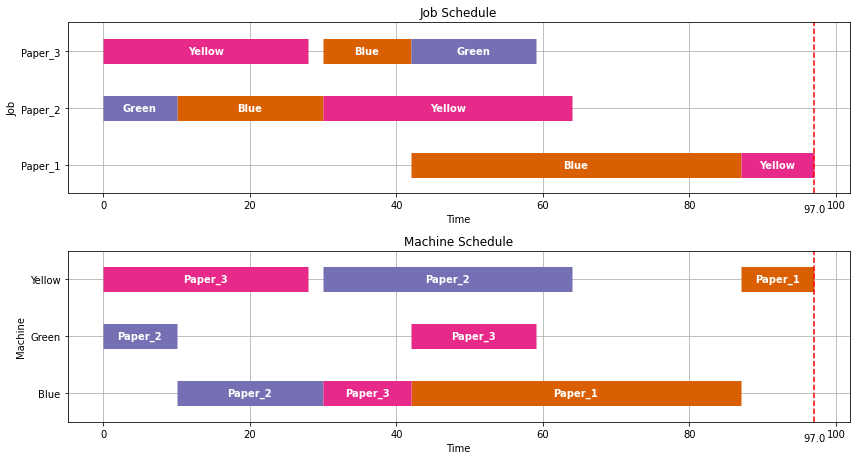
4.3.9. Application to the scheduling of batch processes#
We will now turn our attention to the application of the job shop scheduling problem to the short term scheduling of batch processes. We illustrate these techniques using Example II from Dunn (2013).

Recipe |
Mixer |
Reactor |
Separator |
Packaging |
|---|---|---|---|---|
A |
1.0 |
5.0 |
4.0 |
1.5 |
B |
- |
- |
4.5 |
1.0 |
C |
- |
3.0 |
5.0 |
1.5 |
4.3.9.1. Single product strategies#
Before going further, we create a function to streamline the generation of the TASKS dictionary.
def recipe_to_tasks(jobs, machines, durations):
TASKS = {}
for j in jobs:
prec = (None,None)
for m,d in zip(machines,durations):
task = (j,m)
if prec == (None,None):
TASKS.update({(j,m): {'dur': d, 'prec': None}})
else:
TASKS.update({(j,m): {'dur': d, 'prec': prec}})
prec = task
return TASKS
recipeA = recipe_to_tasks('A', ['Mixer', 'Reactor', 'Separator', 'Packaging'], [1, 5, 4, 1.5])
visualize(jobshop(recipeA))
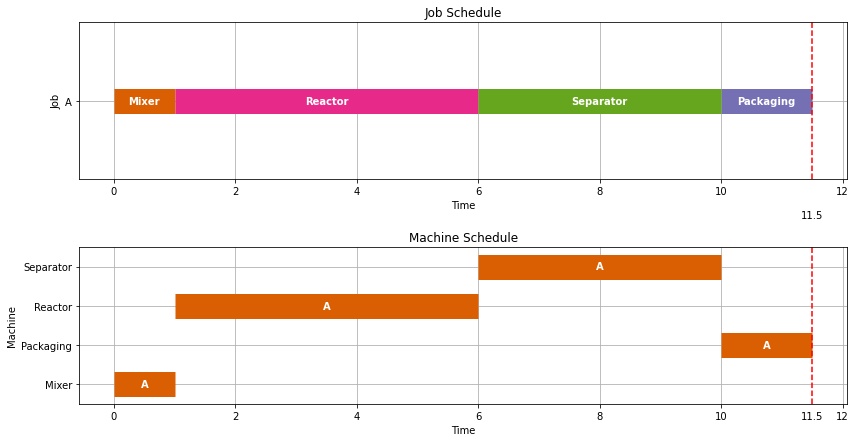
recipeB = recipe_to_tasks('B', ['Separator', 'Packaging'], [4.5, 1])
visualize(jobshop(recipeB))
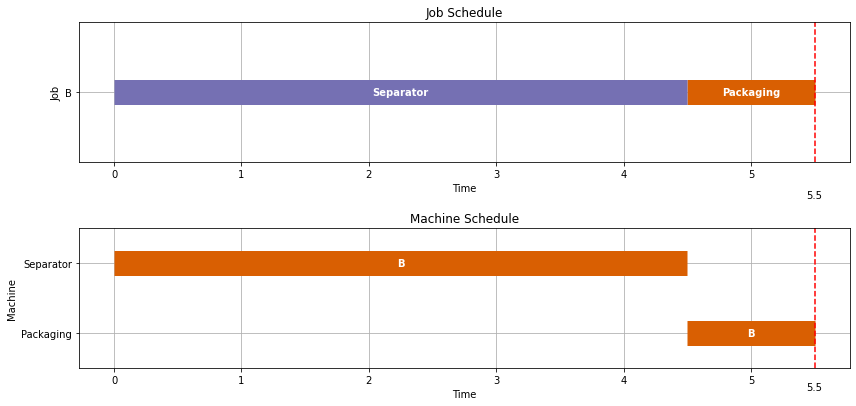
recipeC = recipe_to_tasks('C', ['Separator', 'Reactor', 'Packaging'], [5, 3, 1.5])
visualize(jobshop(recipeC))
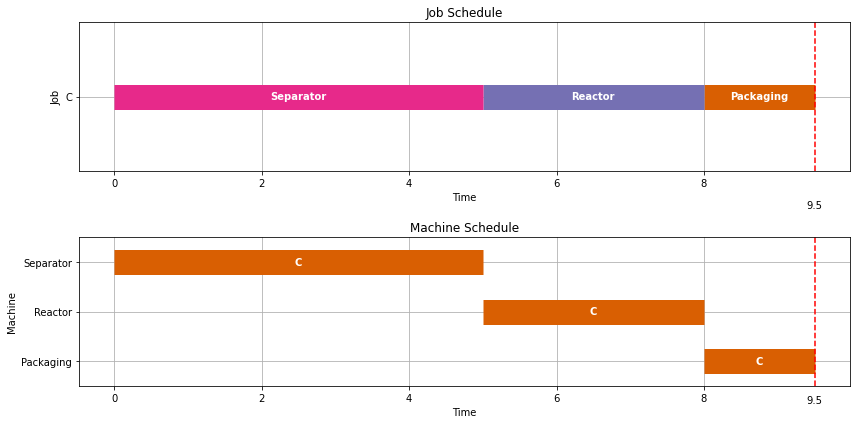
4.3.9.2. Multiple Overlapping tasks#
Let’s now consider an optimal scheduling problem where we are wish to make two batches of Product A.
TASKS = recipe_to_tasks(['A1','A2','A3', 'A4'],['Mixer','Reactor','Separator','Packaging'],[1,5,4,1.5])
results = jobshop(TASKS)
visualize(results)
print("Makespan =", max([task['Finish'] for task in results]))
Makespan = 26.5
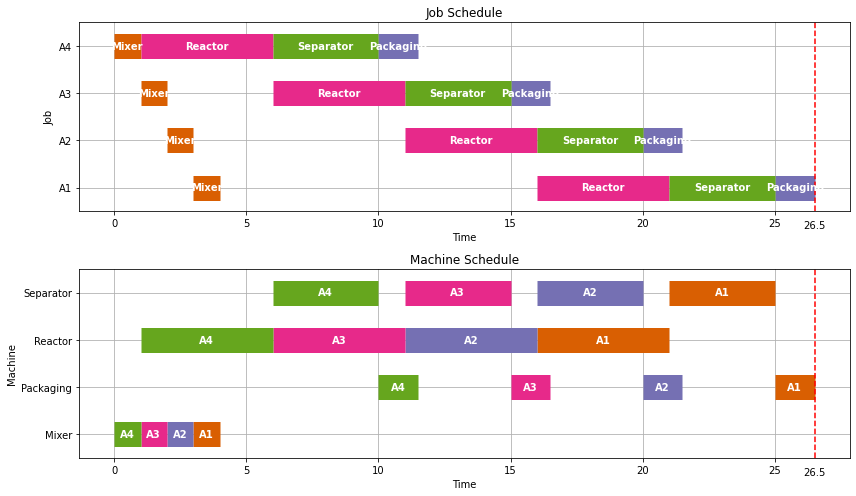
Earlier we found it tood 11.5 hours to produce one batch of product A. As we see here, we can produce a second batch with only 5.0 additional hours because some of the tasks overlap. The overlapping of tasks is the key to gaining efficiency in batch processing facilities.
Let’s next consider production of a single batch each of products A, B, and C.
# update is used to append dictionaries
TASKS = recipeA
TASKS.update(recipeB)
TASKS.update(recipeC)
for k, v in TASKS.items():
print(k, v)
results = jobshop(TASKS)
visualize(results)
print("Makespan =", max([task['Finish'] for task in results]))
('A', 'Mixer') {'dur': 1, 'prec': None}
('A', 'Reactor') {'dur': 5, 'prec': ('A', 'Mixer')}
('A', 'Separator') {'dur': 4, 'prec': ('A', 'Reactor')}
('A', 'Packaging') {'dur': 1.5, 'prec': ('A', 'Separator')}
('B', 'Separator') {'dur': 4.5, 'prec': None}
('B', 'Packaging') {'dur': 1, 'prec': ('B', 'Separator')}
('C', 'Separator') {'dur': 5, 'prec': None}
('C', 'Reactor') {'dur': 3, 'prec': ('C', 'Separator')}
('C', 'Packaging') {'dur': 1.5, 'prec': ('C', 'Reactor')}
Makespan = 15.0

The individual production of A, B, and C required 11.5, 5.5, and 9.5 hours, respectively, for a total of 25.5 hours. As we see here, by scheduling the production simultaneously, we can get all three batches done in just 15 hours.
As we see below, each additional set of three products takes an additionl 13 hours. So there is considerable efficiency gained by scheduling over longer intervals whenever possible.
TASKS = recipe_to_tasks(['A1','A2'],['Mixer','Reactor','Separator','Packaging'],[1,5,4,1.5])
TASKS.update(recipe_to_tasks(['B1','B2'],['Separator','Packaging'],[4.5,1]))
TASKS.update(recipe_to_tasks(['C1','C2'],['Separator','Reactor','Packaging'],[5,3,1.5]))
results = jobshop(TASKS)
visualize(results)
print("Makespan =", max([task['Finish'] for task in results]))
Makespan = 28.0
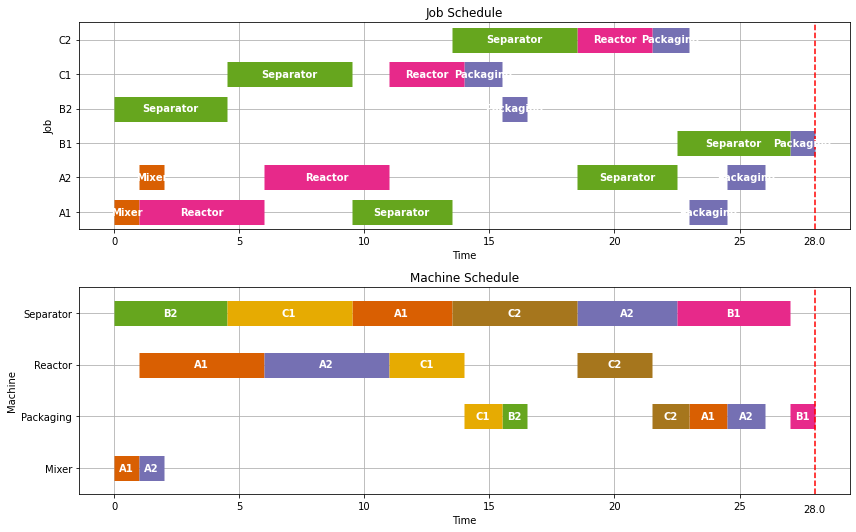
4.3.9.3. Adding time for unit clean out#
A common feature of batch unit operations is a requirement that equipment be cleaned prior to reuse.
In most cases the time needed for clean out would be specific to the equipment and product. But for the purposes this notebook, we implement can implement a simple clean out policy with a single non-negative parameter \(t_{clean} \geq 0\) which, if specified, requires a period no less than \(t_{clean}\) between the finish of one task and the start of another on every piece of equipment.
This policy is implemented by modifying the usual disjunctive constraints to avoid machine conflicts to read
For this purpose, we write a new JobShopModel_Clean
def jobshop_model_clean(TASKS, tclean=0):
model = ConcreteModel()
# tasks is a two dimensional set of (j,m) constructed from the dictionary keys
model.TASKS = Set(initialize = TASKS.keys(), dimen=2)
# the set of jobs is constructed from a python set
model.JOBS = Set(initialize = list(set([j for (j,m) in model.TASKS])))
# set of machines is constructed from a python set
model.MACHINES = Set(initialize = list(set([m for (j,m) in model.TASKS])))
# the order of tasks is constructed as a cross-product of tasks and filtering
model.TASKORDER = Set(initialize = model.TASKS * model.TASKS, dimen=4,
filter = lambda model, j, m, k, n: (k,n) == TASKS[(j,m)]['prec'])
# the set of disjunctions is cross-product of jobs, jobs, and machines
model.DISJUNCTIONS = Set(initialize = model.JOBS * model.JOBS * model.MACHINES, dimen=3,
filter = lambda model, j, k, m: j < k and (j,m) in model.TASKS and (k,m) in model.TASKS)
# load duration data into a model parameter for later access
model.dur = Param(model.TASKS, initialize=lambda model, j, m: TASKS[(j,m)]['dur'])
# establish an upper bound on makespan
ub = sum([model.dur[j,m] for (j,m) in model.TASKS])
model.makespan = Var(bounds=(0, ub))
model.start = Var(model.TASKS, bounds=(0, ub))
model.objective = Objective(expr = model.makespan, sense = minimize)
model.finish = Constraint(model.TASKS, rule=lambda model, j, m:
model.start[j,m] + model.dur[j,m] <= model.makespan)
model.preceding = Constraint(model.TASKORDER, rule=lambda model, j, m, k, n:
model.start[k,n] + model.dur[k,n] <= model.start[j,m])
model.disjunctions = Disjunction(model.DISJUNCTIONS, rule=lambda model,j,k,m:
[model.start[j,m] + model.dur[j,m] + tclean <= model.start[k,m],
model.start[k,m] + model.dur[k,m] + tclean <= model.start[j,m]])
TransformationFactory('gdp.hull').apply_to(model)
return model
model = jobshop_model_clean(TASKS, tclean=0.5)
results = jobshop_solve(model)
visualize(results)
print("Makespan =", max([task['Finish'] for task in results]))
Makespan = 30.5
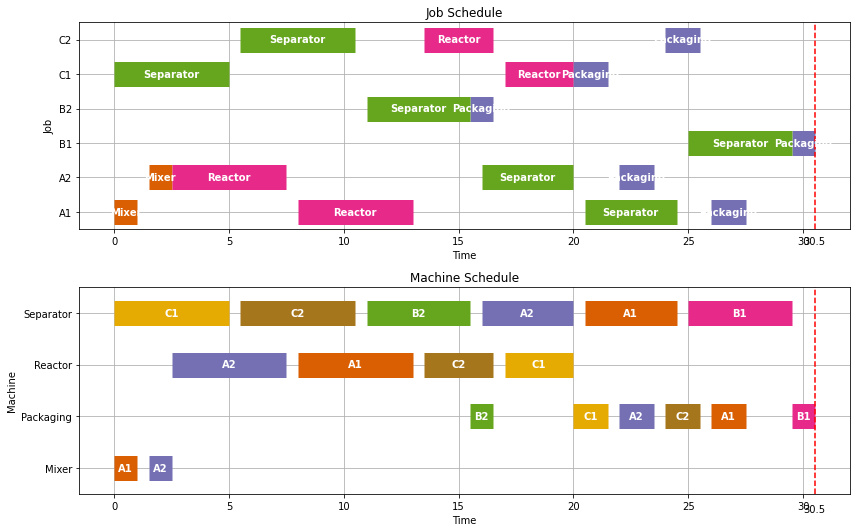
4.3.9.4. Adding a zero wait policy#
One of the issues in the use of job shop scheduling for chemical process operations are situations where there it is not possible to store intermediate materials. If there is no way to store intermediates, either in the processing equipment or in external vessels, then a zero-wait policy may be required.
A zero-wait policy requires subsequent processing machines to be available immediately upon completion of any task. To implement this policy, the usual precident sequencing constraint of a job shop scheduling problem, i.e.,
is changed to
if the zero-wait policy is in effect.
While this could be implemented on an equipment or product specific basis, here we add an optional ZW flag to the JobShop function that, by default, is set to False.
def jobshop_model_clean_zw(TASKS, tclean=0, ZW=False):
model = ConcreteModel()
# tasks is a two dimensional set of (j,m) constructed from the dictionary keys
model.TASKS = Set(initialize = TASKS.keys(), dimen=2)
# the set of jobs is constructed from a python set
model.JOBS = Set(initialize = list(set([j for (j,m) in model.TASKS])))
# set of machines is constructed from a python set
model.MACHINES = Set(initialize = list(set([m for (j,m) in model.TASKS])))
# the order of tasks is constructed as a cross-product of tasks and filtering
model.TASKORDER = Set(initialize = model.TASKS * model.TASKS, dimen=4,
filter = lambda model, j, m, k, n: (k,n) == TASKS[(j,m)]['prec'])
# the set of disjunctions is cross-product of jobs, jobs, and machines
model.DISJUNCTIONS = Set(initialize = model.JOBS * model.JOBS * model.MACHINES, dimen=3,
filter = lambda model, j, k, m: j < k and (j,m) in model.TASKS and (k,m) in model.TASKS)
# load duration data into a model parameter for later access
model.dur = Param(model.TASKS, initialize=lambda model, j, m: TASKS[(j,m)]['dur'])
# establish an upper bound on makespan
ub = sum([model.dur[j,m] for (j,m) in model.TASKS])
# to implement a zero-wait policy
model.bigM = Param(initialize=ub if ZW else 0)
model.makespan = Var(bounds=(0, ub))
model.start = Var(model.TASKS, bounds=(0, ub))
model.objective = Objective(expr = model.makespan, sense = minimize)
model.finish = Constraint(model.TASKS, rule=lambda model, j, m:
model.start[j,m] + model.dur[j,m] <= model.makespan)
def _preceding(model, j, m, k, n):
if ZW:
return model.start[k,n] + model.dur[k,n] == model.start[j,m]
else:
return model.start[k,n] + model.dur[k,n] <= model.start[j,m]
model.preceding = Constraint(model.TASKORDER, rule=_preceding)
model.disjunctions = Disjunction(model.DISJUNCTIONS, rule=lambda model,j,k,m:
[model.start[j,m] + model.dur[j,m] + tclean <= model.start[k,m],
model.start[k,m] + model.dur[k,m] + tclean <= model.start[j,m]])
TransformationFactory('gdp.hull').apply_to(model)
return model
model = jobshop_model_clean_zw(TASKS, tclean=0.5, ZW=True)
results = jobshop_solve(model)
visualize(results)
print("Makespan =", max([task['Finish'] for task in results]))
Makespan = 32.0
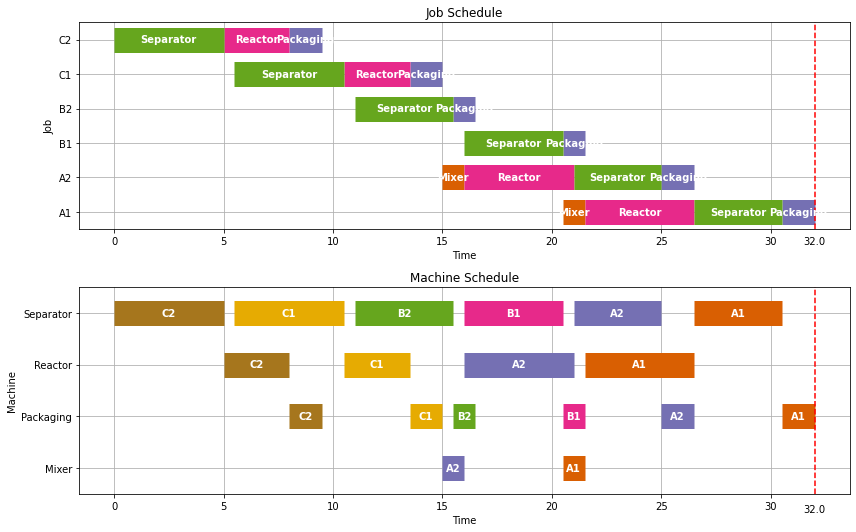
4.3.10. Solving the LA19 benchmark problem with NEOS#
The file jobshop1.txt contains 82 benchmark problems from a well-known collection of job shop scheduling problems in the OR-Library maintained by J. E. Beasley. The data format for each example consists of a single line for each job. The data on each line is a sequence of (machine number, time) pairs showing the order in which machines process each job.
LA19 is a benchmark problem for job shop scheduling introduced by Lawrence in 1984, and a solution presented by Cook and Applegate in 1991. The following cell may take many minutes to hours to run, depending on the choice of solver and hardware. To run, uncomment the the last lines in the cell.
data = """
2 44 3 5 5 58 4 97 0 9 7 84 8 77 9 96 1 58 6 89
4 15 7 31 1 87 8 57 0 77 3 85 2 81 5 39 9 73 6 21
9 82 6 22 4 10 3 70 1 49 0 40 8 34 2 48 7 80 5 71
1 91 2 17 7 62 5 75 8 47 4 11 3 7 6 72 9 35 0 55
6 71 1 90 3 75 0 64 2 94 8 15 4 12 7 67 9 20 5 50
7 70 5 93 8 77 2 29 4 58 6 93 3 68 1 57 9 7 0 52
6 87 1 63 4 26 5 6 2 82 3 27 7 56 8 48 9 36 0 95
0 36 5 15 8 41 9 78 3 76 6 84 4 30 7 76 2 36 1 8
5 88 2 81 3 13 6 82 4 54 7 13 8 29 9 40 1 78 0 75
9 88 4 54 6 64 7 32 0 52 2 6 8 54 5 82 3 6 1 26
"""
TASKS = {}
for job, line in enumerate(data.splitlines()[1:]):
nums = line.split()
prec = None
for m, dur in zip(nums[::2], nums[1::2]):
task = (f"J{job}",f"M{m}")
TASKS[task] = {'dur':int(dur), 'prec':prec}
prec = task
#pd.DataFrame(TASKS).T
Depending on the choice of solver, this benchmark example may require from minutes to hours of computational effort on a laptop. An alternative to solving on a laptop is to submit the job to NEOS, a free internet-based service for solving optimization problems hosted by the University of Wisconsin and utilizing high performance servers at locations across the globe.
The following cell shows how to solve a model using CPLEX, a high performance commericial solver, on NEOS. The solution may take several minutes, and depends on the current length of the NEOS job queue.
def jobshop_solve_neos(model):
solver_manager = SolverManagerFactory('neos')
solver_manager.solve(model, opt='cplex')
results = [{'Job': j,
'Machine': m,
'Start': model.start[j, m](),
'Duration': model.dur[j,m],
'Finish': model.start[(j, m)]() + model.dur[j,m]}
for j,m in model.TASKS]
return results
model = jobshop_model(TASKS)
results = jobshop_solve_neos(model)
visualize(results)
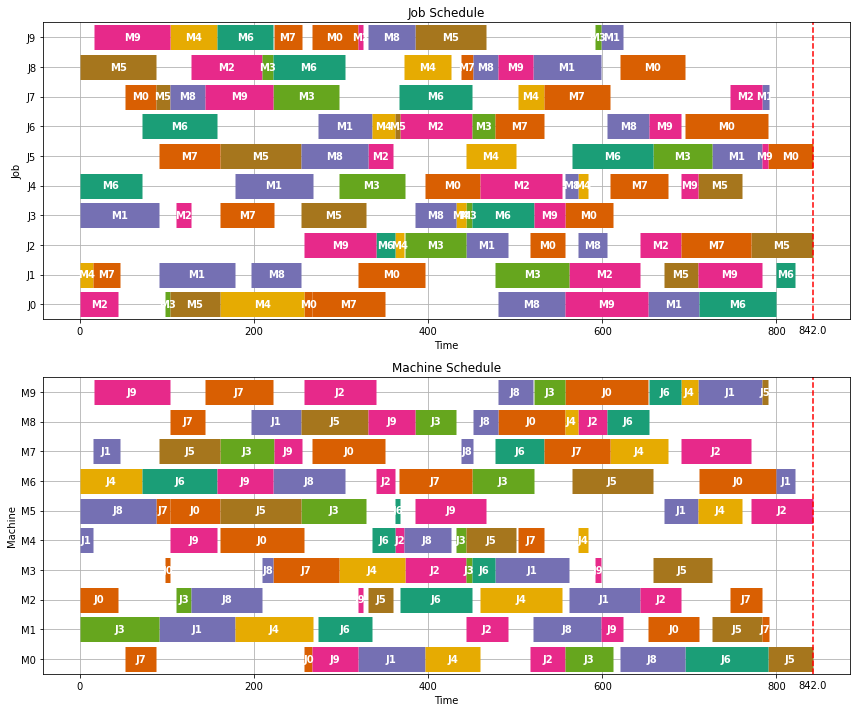
4.3.11. References#
Applegate, David, and William Cook. “A computational study of the job-shop scheduling problem.” ORSA Journal on computing 3, no. 2 (1991): 149-156. pdf available
Beasley, John E. “OR-Library: distributing test problems by electronic mail.” Journal of the operational research society 41, no. 11 (1990): 1069-1072. OR-Library
Guéret, Christelle, Christian Prins, and Marc Sevaux. “Applications of optimization with Xpress-MP.” contract (1999): 00034.
Manne, Alan S. “On the job-shop scheduling problem.” Operations Research 8, no. 2 (1960): 219-223.
4.3.12. Exercises#
4.3.12.1. Task specific cleanout#
Clean out operations are often slow and time consuming. Further more, the time required to perform a clean out frequently depends on the type of machine, and the task performed by the machine. For this exercise, create a data format to include task-specific clean out times, and model the job shop model to accomodate this additional informaton.
4.3.12.2. Computational impact of a zero-wait policy#
Repeat the benchmark problem calculation, but with a zero-wait policy. Does the execution time increase or descrease as a consequence of specifying zero-wait?
